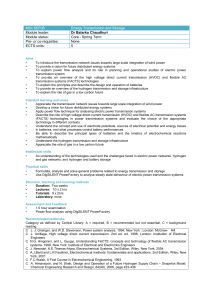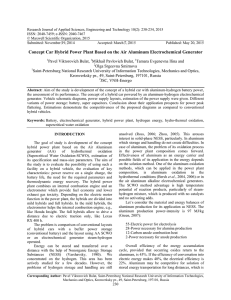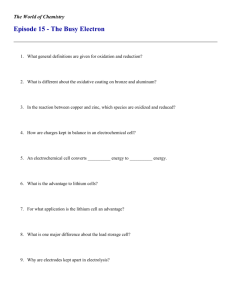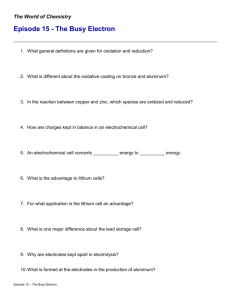Research Journal of Applied Sciences, Engineering and Technology 10(2): 230-234,... DOI:10.19026/rjaset.10.2576
advertisement
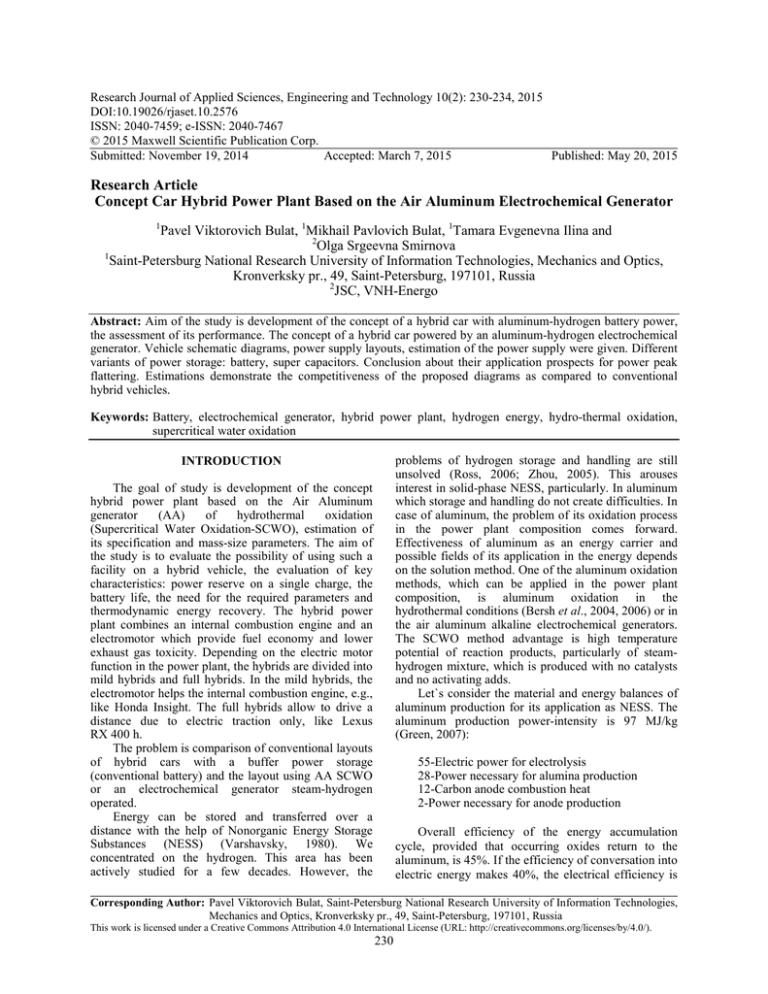
Research Journal of Applied Sciences, Engineering and Technology 10(2): 230-234, 2015 DOI:10.19026/rjaset.10.2576 ISSN: 2040-7459; e-ISSN: 2040-7467 © 2015 Maxwell Scientific Publication Corp. Submitted: November 19, 2014 Accepted: March 7, 2015 Published: May 20, 2015 Research Article Concept Car Hybrid Power Plant Based on the Air Aluminum Electrochemical Generator 1 Pavel Viktorovich Bulat, 1Mikhail Pavlovich Bulat, 1Tamara Evgenevna Ilina and 2 Olga Srgeevna Smirnova 1 Saint-Petersburg National Research University of Information Technologies, Mechanics and Optics, Kronverksky pr., 49, Saint-Petersburg, 197101, Russia 2 JSC, VNH-Energo Abstract: Aim of the study is development of the concept of a hybrid car with aluminum-hydrogen battery power, the assessment of its performance. The concept of a hybrid car powered by an aluminum-hydrogen electrochemical generator. Vehicle schematic diagrams, power supply layouts, estimation of the power supply were given. Different variants of power storage: battery, super capacitors. Conclusion about their application prospects for power peak flattering. Estimations demonstrate the competitiveness of the proposed diagrams as compared to conventional hybrid vehicles. Keywords: Battery, electrochemical generator, hybrid power plant, hydrogen energy, hydro-thermal oxidation, supercritical water oxidation problems of hydrogen storage and handling are still unsolved (Ross, 2006; Zhou, 2005). This arouses interest in solid-phase NESS, particularly. In aluminum which storage and handling do not create difficulties. In case of aluminum, the problem of its oxidation process in the power plant composition comes forward. Effectiveness of aluminum as an energy carrier and possible fields of its application in the energy depends on the solution method. One of the aluminum oxidation methods, which can be applied in the power plant composition, is aluminum oxidation in the hydrothermal conditions (Bersh et al., 2004, 2006) or in the air aluminum alkaline electrochemical generators. The SCWO method advantage is high temperature potential of reaction products, particularly of steamhydrogen mixture, which is produced with no catalysts and no activating adds. Let`s consider the material and energy balances of aluminum production for its application as NESS. The aluminum production power-intensity is 97 MJ/kg (Green, 2007): INTRODUCTION The goal of study is development of the concept hybrid power plant based on the Air Aluminum generator (AA) of hydrothermal oxidation (Supercritical Water Oxidation-SCWO), estimation of its specification and mass-size parameters. The aim of the study is to evaluate the possibility of using such a facility on a hybrid vehicle, the evaluation of key characteristics: power reserve on a single charge, the battery life, the need for the required parameters and thermodynamic energy recovery. The hybrid power plant combines an internal combustion engine and an electromotor which provide fuel economy and lower exhaust gas toxicity. Depending on the electric motor function in the power plant, the hybrids are divided into mild hybrids and full hybrids. In the mild hybrids, the electromotor helps the internal combustion engine, e.g., like Honda Insight. The full hybrids allow to drive a distance due to electric traction only, like Lexus RX 400 h. The problem is comparison of conventional layouts of hybrid cars with a buffer power storage (conventional battery) and the layout using AA SCWO or an electrochemical generator steam-hydrogen operated. Energy can be stored and transferred over a distance with the help of Nonorganic Energy Storage Substances (NESS) (Varshavsky, 1980). We concentrated on the hydrogen. This area has been actively studied for a few decades. However, the 55-Electric power for electrolysis 28-Power necessary for alumina production 12-Carbon anode combustion heat 2-Power necessary for anode production Overall efficiency of the energy accumulation cycle, provided that occurring oxides return to the aluminum, is 45%. If the efficiency of conversation into electric energy makes 40%, the electrical efficiency is Corresponding Author: Pavel Viktorovich Bulat, Saint-Petersburg National Research University of Information Technologies, Mechanics and Optics, Kronverksky pr., 49, Saint-Petersburg, 197101, Russia This work is licensed under a Creative Commons Attribution 4.0 International License (URL: http://creativecommons.org/licenses/by/4.0/). 230 Res. J. Appl. Sci. Eng. Technol., 10(2): 230-234, 2015 22%. Aluminum may be competitive for solution of stored energy transportation for long distances, which is provided, particularly, by aluminum usage as fuel for transport plants. Thereby, we see the aluminum use in the vehicle hybrid power plants very promising. Perspective application of the energy storage systems in transport are considered in works вработах (Anikeev et al., 1995; Loldin et al., 1999; Pupynin and Shevlyugin, 1998; Maxwell Technologies, 2004). It is widely accepted that the most promising vehicles are the cars with fuel cells based on polyethylene electrolytes with hydrogen fuel. In the late XX century development of industrial prototypes was started. However, they met with failure because of the problems in provision of hydrogen fuel delivery and storage security and in a higher (uncompetitive) cost of fuel cells, as compared to conventional and other alternative solutions. The following is the estimation of the component layout, the schematic diagram and dimensions of the car hybrid power plant with electrochemical generator. Fig. 1: Sequential hybrid layout HYBRID CAR MATERIALS AND METHODS-HYBRID COMPONENT LAYOUT Hybrid car conventional versions: Today, instead of fuel cell vehicles the hybrid transport based on the internal combustion engine and electric drive are surging. The hybrid transport allows to save the existing fueling system. There are three versions of hybrid layout: sequential layout, parallel layout, mixed layout. In the sequential layout, wheels are driven by the electromotor and a small internal combustion engine turns the electrical power generator (Fig. 1). No need for a gear box and a powerful internal combustion engine, but high output batteries are needed. Power units of rock handlers and some buses are built according to such a pattern. Parallel layout (Fig. 2) is the most common one. Modern hybrid car built according to the parallel layout is equipped with an electromotor (10 (10-15 kilowatt) which helps the internal combustion engine during its acceleration and during braking it stores energy due to braking energy recuperation. This king of cars are more economical than conventional ones. As a rule, a variator can be used as transmission. Lithium-ion batteries and lithium-polymeric polymeric batteries are used as a power source. Mild hybrids need no high highcapacity batteries. s. Also, attention is paid to super capacitors which can give up high power short short-time current. Other popular layouts are mixed ones (Fig. 3) or sequential-and-parallel parallel hybrid layouts where an internal combustion engine turns the wheels together with an electromotor ectromotor and, at the same time, it turns a generator. The planetary drive transforms transmission into continuously variable transmission. Fig. 2: Parallel hybrid layout Fig. 3: Sequential-and-parallel hybrid layout Layout of hybrid transmission with an electrochemical generator: Vehicles with “metal-air” “metal electrochemical generators are promising, because the energy indices of such electrochemical generators are very close to the indices of hydrogen fuel cells and the maintenance workability induces are considerably higher. Air aluminum electrochemical generator differs from other electrochemical systems because its 231 Res. J. Appl. Sci. Eng. Technol., 10(2): 230-234, 2015 Table 1: Energy indices of the most effective anode mate materials in the electrochemical circuits with oxygen Theoretical electrode Theoretical specific Energy carrier potential, V energy, MJ/kg H2 1.23 119.0 Al 2.72 29.16 Mg 2.363 18.77 Zn 0.76 2.24 powders) exist on an industrial scale. Aluminum energy storage yields to hydrogen energy storage only (Table 1). Possible schematic diagram of an electromotor powered from an air aluminum electrochemical generator is given in Fig. 4. Voltage up-converter is designed for power effective transmission from an electrochemical generator into a storage system, for limitation of the rated output current of an electrochemical generator and for maintenance of the storage system charging rate on the constant level. Moreover, it provides matching of the electrochemical generator nerator current-voltage characteristic, storage system and micro controller of the traction electric motor. Electric circuits of the electric motor and storage system are given in Fig. 5. aluminum anode and electrolyte need to be replaced. Products of electrochemical reactions in the “metal “metal-air” electrochemical generator are valuable raw material which relatively high cost makes attractive the exchange scheme when a used electrochemical generator erator is utilized in exchange for new one. An electric vehicle can be filled by means of exchange of an air aluminum electrochemical generator for a similar one available at the filling station. At such a station you can change anodes, draw aluminate-alka alkaline pulp from and wash the settling tank. The collected aluminate aluminatealkaline pulp should be sent to an alumina refinery for aluminum electrolysis. Residual aluminum anodes drawn from the air aluminum electrochemical generator should be sent to the aluminum alloy factory. The electrochemical generator service infrastructure consists of four parts, three of which (electrolyte preparation, aluminum electrolysis, production of alloys and COMPUTATION RESULTS AND DISCUSSION-COMPUTATION OF THE ELECTRIC PLANT PLAN WITH AN ELECTROCHEMICAL GENERATOR GENE Required power estimation: To estimate the electric drive required power it is necessary to use the international urban driving cycle ISO/CD 8714 (Fig. 6). Let`s consider the motion of a 1 ton car driven by an electrochemical generator. Fig. 4: Schematic diagram of an electrochemical generator electric drive Fig. 5: Schematic diagram of the power network 232 Res. J. Appl. Sci. Eng. Technol., 10(2): 230-234, 2015 power is less than the maximum required power for the wheel driving. The generator works in the approximately constant rated mode and lack of power at individual moments is covered by an in-process storage system, which can be in the form of a battery or a super capacitor. If a battery is taken as the in-process storage system, it is considered that the storage electrochemical capacity remains invariant due to constant charging from the electrochemical generator. Therefore, for estimation of the battery characteristics, it is necessary to use two criteria: the energy storage for one driving cycle and the urban cycle peak power. The specific energy of, for example, a nickel metal-hydride cell makes up 65 watt-h/kg. In this case, the estimation of its mass, according to the energy necessary storage, as follows: 60 Velocity (km/h) 50 40 30 20 10 0 0 50 100 Time (s) 150 200 Fig. 6: Urban cycle ISO/CD 8714 Power (kw) 12 10 8 6 4 2 0 -2 0 -4 -6 -8 83.8/65≈1.3 kg 50 100 150 For the second estimation, it is necessary to divide the peak required power by the specific power of a nickel metal-hydride cell -90 watt/kg, then: 200 12000/90≈133 kg Time (s) In such a way, the cell mass is specified according to the required peak power. In case of super capacitors, the situation is opposite. Taking into account the specific energy of a super capacitor 4 watt·h/kg and its specific power 3.8 kilowatt/kg: Fig. 7: Cyclogram of the electromotor required power for a car driving according to the standard urban cycle ISO/CD 8714 The drive power necessary for travel consists of three components for overcoming the rolling friction force (Р1), the aerodynamic resistance force (Р2) and the inertial force (Р3) during acceleration: 83.8/4≈21 kg 12000/3800≈3.15 kg From the comparison of the mass characteristics of nickel metal-hydride cell and a super capacitor, you can see that to cover the peak power in transport combined power plants it is very perspective to apply super capacitors. A super capacitor battery can be used as a single power storage system. An average power of a generator is specified according to the total energy consumed during 195 s of the urban cycle (it is recognized that the following cycles repeat). It is necessary to insert a power margin (it is usually equal to 1.4), then, according to efficiency of the electromotor ηm = 0.93, the transmission ηt = 0.95 and the inverter ηp = 0.98, the generator maximum power makes up about 3 kilowatt, the rated powerabout 2 kilowatt. According to the current efficiency of air aluminum electrochemical generator with alkali electrolyte in 50%, such a hybrid layout considerably yields hydrogen fuel cells. Р = Р1+Р2+Р3 where, Р1 = mg Fru m = Mass g = Gravitational acceleration Fr = Rolling friction force coefficient (0.015) u = Velocity Р2 = 1/2Сdρu3 S Сd = Drag coefficient (equal to 0.3) ρ = Air density under standard conditions S = Characteristic area of the car frontal projection Р3 = mа а = Acceleration of the car Figure 7 shows the results of computation of the car electromotor required power while driving according to the urban cycle. Figure 7 you can see that the maximum required power of the electromotor is 12 kilowatt, which is very close to the power of electromotors of production hybrid cars. Estimation of the hybrid layout with full energy utilization: The hydrogen generated in the process of parasitic corrosion of the anode alloy is used in the layout with an air aluminum electrochemical generator and an air hydrogen fuel cell. It goes to the hydrogen air Estimation of the characteristics of the storage system and the generator power: The current source 233 Res. J. Appl. Sci. Eng. Technol., 10(2): 230-234, 2015 Fig. 8: Volumetric piston machine for utilization of energy of steam-hydrogen mixture fuel cell for direct production of electricity. The fuel cell efficiency, for example, based on a protonconducting membrane makes up about 50%. Computation shows that for the effectiveness of the special fuel cells on basis of indium alloys, the heat energy efficiency must be not less than 90%. This can be achieved by hydrogen combustion and by use of generated steam in a volumetric machine (Fig. 8). Its power can be used for electricity generation and for direct recovery of the drive power. Cylinder expansion ratio-15. The machine is controlled by valves with pilot water hydrocontrol similar to the COMMONRAIL system in the diesel automation. Bersh, A.V., N.N. Zhukov, L. IvanovYu, V.K. Ikonnikov, A. MazalovYu, V.Y. Ryzhkin and O.A. Trubachev, 2004. Method for production of hydroxide or oxide of aluminum and hydrogen. Patent Russian Federation, №. 2223221. Bersh, A.V., Y.L. Ivanov, Y.A. Mazalov, A.V. Glukhov and O.A. Trubachev, 2006. Method of production of hydroxide or oxide of aluminum and hydrogen and the device for its production. Patent Russian Federation, №. 2278077. Green, J.A.S., 2007. Aluminum Recycling and Processing for Energy Conservation and Sustainability. ASM International, Materials Park, Ohio, pp: 288. Loldin, V.M., E.N. Alekseev and L.V. Vykhodtsev, 1999. Application of energy storage in the power supply systems. Lokomotiv, 12. Maxwell Technologies, 2004. How to Determine an Appropriate Size Ultracapacitor for Your Application. Application Note, Document 1007236 Rev. 2, 10/2004. Pupynin, V.I. and M.V. Shevlyugin, 1998. Development of energy-saving circuits for the railway traction power supply with direct current 3.3 kilowatt and with energy storage systems. Proceeding of Resource-Saving Technologies on Railway Transport. Collection of Abstracts of the Scientific and Practical Conference, MIIT. Ross, D.K., 2006. Hydrogen storage: The major technological barrier to the development of hydrogen fuel cell cars. Vacuum, 80(10): 1084-1089. Varshavsky, I.L., 1980. Energy accumulating substances and their application. Kiev: Nauk. Dumka, pp: 240. Zhou, L., 2005. Progress and problems in hydrogen storage methods. Renew. Sust. Energ. Rev., 9(4): 395-408. CONCLUSION We considered the schematic diagram of a hybrid car with an air aluminum electrochemical generator and a super capacity battery instead of an accumulator. The computation demonstrates that the electrical part of such a hybrid automobile has the characteristics comparable to the characteristics of conventional hybrid cars. ACKNOWLEDGMENT This study was prepared as part of the "1000 laboratories" program with the support of SaintPetersburg National Research University of Information Technologies, Mechanics and Optics (University ITMO). REFERENCES Anikeev, I.P., V.A. Koshena, A.N. Korneev and A.S. Lyashenko, 1995. Application of the energy storage systems doe diesel start. Lokomotiv, 3. 234
